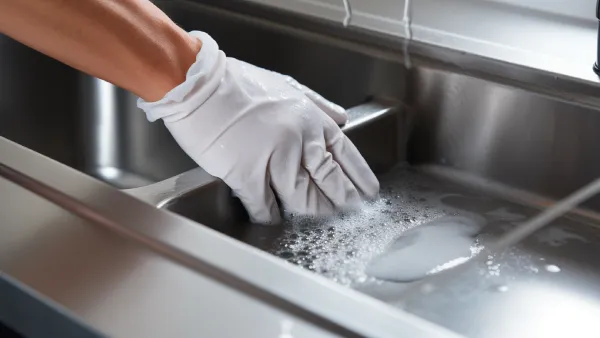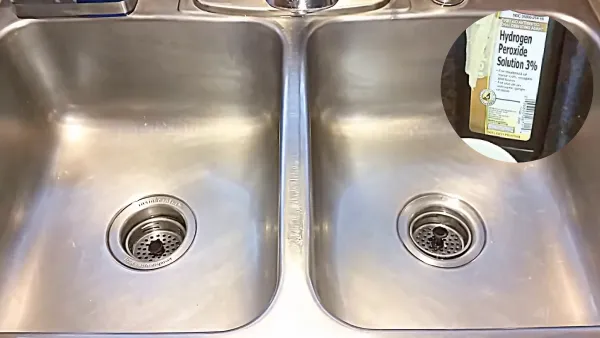Last Updated on November 14, 2023
Adhesive is often a stubborn nuisance on your stainless steel kitchen sink. Whether it’s remnants from labels, glue, or tape, dealing with sticky residue on this pristine surface is certainly a hassle. But there are effective solutions at your fingertips to remove adhesive from your stainless steel sink.
You can remove the adhesive with acetone, a powerful solvent in nail polish remover. Apply the acetone to the adhesive, let it sit for a few minutes, then gently wipe away the dissolved glue. Finish by cleaning the sink with warm, soapy water.
Alternatively, you can opt for a natural approach using lemon juice and a plastic scraper. We will explore two tried-and-true methods for eliminating adhesive from your sink, along with a step-by-step guide.
How to Remove Adhesive From Stainless Steel Kitchen Sink: Step-by-Step Instructions

To remove adhesive from your stainless steel kitchen sink, you have 2 options.
1. Method 1: Using Acetone
- Step 1: Gather Supplies and Ensure Ventilation
- Step 2: Apply Acetone
- Step 3: Wipe Away
- Step 4: Clean the Sink
2. Method 2: Using Lemon Juice and a Plastic Scraper
- Step 1: Collect the Supplies and Apply Lemon Juice
- Step 2: Use the Plastic Scraper
- Step 3: Rinse and Dry the Sink
Let’s go over each method in detail so you can remove adhesive from stainless steel sinks.
Method 1: Using Acetone
You can remove adhesive from your stainless steel sink with acetone, found in nail polish remover. To get started, follow these steps:
Step 1: Gather Supplies and Ensure Ventilation
Make sure you have all the necessary supplies and enough ventilation in the area before starting the process. Gather acetone, a cotton ball or swab, a clean cloth or rag, dish soap, and water.
You have to ensure proper ventilation as acetone emits noxious fumes. Wear a respirator and gloves for added protection if you’re fume-sensitive.
Step 2: Apply Acetone
Now, take your cotton ball or swab and, using gentle circular motions, apply acetone to the adhesive on your stainless steel kitchen sink.
Take a few minutes to let it sit. Be sure to apply enough acetone to cover the adhesive and let it work its magic fully.
Step 3: Wipe Away
Using a clean cloth, gently wipe away the dissolved glue in a circular motion. This step effectively removes adhesive from your stainless steel kitchen sink.
Step 4: Clean the Sink
After removing the adhesive, rinse the sink with warm water to remove any remaining adhesive.
Then, scrub it with a mild dish soap to remove any residue. You can gently scrub the area for tough adhesive stains using a non-abrasive sponge or cloth. Make sure to thoroughly rinse the sink after scrubbing to remove all soap residue.
Method 2: Using Lemon Juice and a Plastic Scraper
This natural method can also effectively remove adhesive from the stainless steel kitchen sink:
Step 1: Collect the Supplies and Apply Lemon Juice
To effectively remove the adhesive stain, you’ll need freshly squeezed lemon juice, an old toothbrush, a plastic scraper, and a clean cloth or towel.
Once you have these supplies, dip the toothbrush into the lemon juice and scrub the adhesive stain.
Step 2: Use the Plastic Scraper
Take a plastic scraper and gently scrape off the adhesive from the surface of the stainless steel kitchen sink. Be careful not to apply too much pressure to avoid scratching the sink.
Step 3: Rinse and Dry the Sink
Now, run water over the sink to thoroughly rinse away any remaining residue from the adhesive. Make sure to use hot water, as it helps to loosen the adhesive.
Use your hand or a clean cloth to scrub the sink, focusing on areas where the adhesive was present. Pay close attention to corners and edges.
Continue rinsing until all traces of adhesive are gone.
What to Avoid When Removing Adhesive From a Stainless Steel Kitchen Sink?
You need to avoid the following when attempting to remove adhesive from a stainless steel kitchen sink:
1. Avoid Abrasive Tools
Avoid abrasive tools like steel wool or abrasive scouring pads, as they can scratch the surface. Use a soft cloth or sponge with a non-abrasive cleaner to safely get rid of adhesive.
You should never use sandpaper or sharp metal objects, as they can cause permanent damage to the sink.
2. Avoid Excessive Force
Avoid applying excessive force to remove adhesive from a stainless steel kitchen sink, especially if you’re using a plastic scraper or toothbrush.
Excessive force can cause scratches on the kitchen sink’s surface, which can damage the sink permanently.
3. Be Cautious When Using Flammable Substances
In the case of removing adhesive from a stainless steel kitchen sink, be cautious when using flammable substances like acetone, nail polish remover, or lighter fluid.
These substances should be kept away from an open flame, and safety precautions should be followed.
It’s also important to note that these substances can cause damage to the sink’s surface if not used properly. To avoid damage, use these substances sparingly and carefully.
4. Avoid Damaging Surroundings
When removing a sticky substance from a stainless steel sink using acetone or other strong solvents, don’t spill them on the countertops. These strong solvents can cause damage to wood finishes and other materials.
To avoid damaging the surroundings, use a drop cloth or plastic sheet to cover nearby surfaces or work on the adhesive removal away from other surfaces. It’s also important to clean up any spills or drips immediately to prevent damage.
Can hydrogen peroxide effectively remove adhesive from a stainless steel sink?

Hydrogen peroxide can be used to remove adhesive from a stainless steel kitchen sink, although its effectiveness may vary depending on the type and age of the adhesive.
To use hydrogen peroxide for this purpose, you can soak a cotton swab or ball in hydrogen peroxide and apply it to the adhesive area.
Allow it to sit for a few minutes to soften the adhesive, then gently rub and wipe away the residue.
While hydrogen peroxide can work for some adhesive types, it may not be as potent as acetone or nail polish remover, so you may need to repeat the process or consider other methods if the adhesive is particularly stubborn.
Always test a small, inconspicuous area of the sink first to ensure it doesn’t damage the stainless steel finish.
Achieve a Spotless Adhesive-free, Shine-restored Sink
You’ve got two ways to remove adhesive from stainless steel sinks: acetone or lemon juice and a plastic scraper.
Following these step-by-step instructions, you can say goodbye to the stubborn adhesive residue and restore the pristine shine of your sink.
However, it’s essential to exercise caution when handling flammable substances, avoid abrasive tools, and refrain from using excessive force to prevent any damage.
Whether you choose the solvent-based approach or the natural remedy, always remember to test a small area first, ensuring your sink remains unharmed.
With the right techniques and a little patience, your stainless steel sink will be adhesive-free and gleaming in no time.

